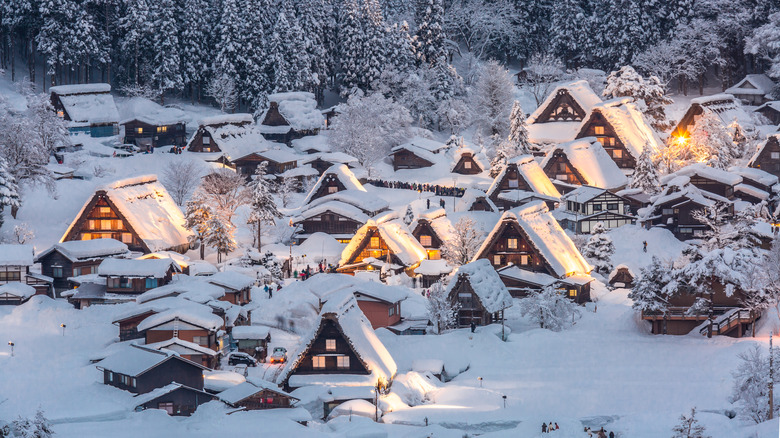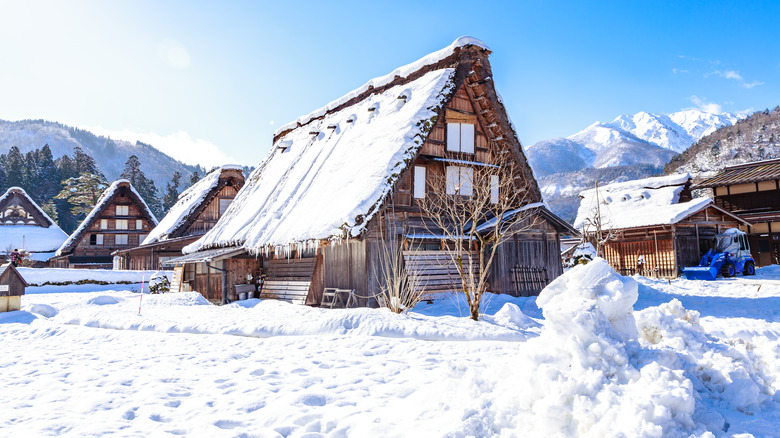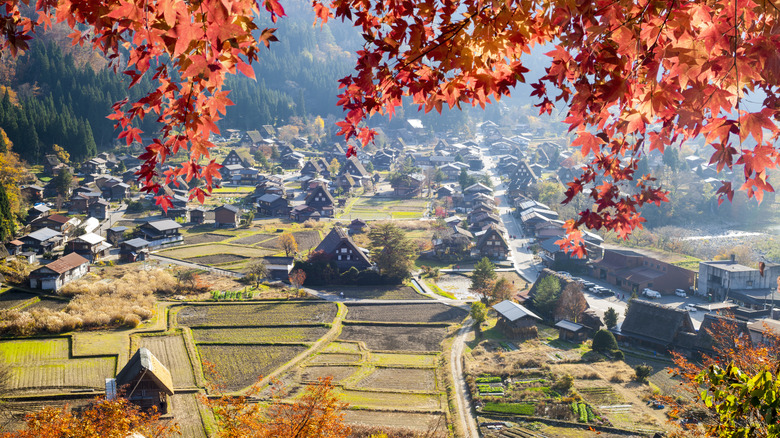Visit This Japanese Village For A Picture Perfect Winter Vacation
On a trip to Japan, it's easy to gravitate toward big cities like Tokyo and Osaka simply because they hold some of the country's busiest international airports, and you might be flying in there. As you venture outside the concrete jungle, however, you'll find a mountainous geography where seasonal changes frame the landscape in various colors, including wintery white.
According to the Ministry of Land, Infrastructure, Transportation and Tourism, around 75% of Japan is covered in mountains. About 200 of those are volcanic, approximately 60 of which are active. Look beyond the capital or even the snow-capped Mt. Fuji (one of the active ones), and there's still no end to the country's unmissable tourist destinations.
Nestled away in a river valley in Gifu Prefecture is the village of Shirakawa-go, a UNESCO World Heritage Site known for its scenic, thatched-roof farmhouses. Here, you can see a different side of Japan in a place once isolated from the outside world — even today, some local mountain roads close in winter due to heavy snowfall. If you can brave the winding journey, though, you'll be rewarded with the breathtaking sight of a 200-year-old village that looks like a snow globe scene come to life. The very name "Shirakawa" means "white river"; this is one of the world's snowiest places, with an annual snowfall of up to 35 feet.
The winter wonderland of Shirakawa-go
The sloping roofs of Shirakawa-go's farmhouses were designed expressly to help snow slide off and not build up in winter. Together with the roofs in neighboring Gokayama, they're the only remaining example of Gassho-zukuri (meaning praying hands) architecture in Japan. Sericulture farmers used the upper rafters of the houses to rear silkworms, while the community at large cultivated mulberry trees. This manner of living in harmony with the environment earned Shirakawa-go its World Heritage status and continues to make it such a unique time capsule.
Some of the Gassho houses at Shirakawa-go are now guesthouses. You can get a taste of what it was like to live in one by booking an overnight reservation and enjoying dinner and breakfast around the sunken hearth. Two places to get an elevated view of the whole village are the Shiroyama viewpoint and the Ogi-machi Castle ruin observation area. These are accessible by a walking trail and shuttle bus, respectively (weather permitting). When you reach the top, you'll see the postcard view of Shirakawa-go's farmhouses, surrounded by mountains. They're even more lovely when covered in snow and illuminated during the evening light-up event in January and February.
There are several different combined bullet trains and bus routes that will take you to Shirakawa-go. The fastest, just upwards of two hours, is from Tokyo Station to Toyama via the Hokuriku Shinkansen train. From there, it's another 90 minutes by bus to Shirakawa-go.
A place for all seasons
If you're visiting Japan in February, you might combine Shirakawa-go with a trip to the Olympic city of Sapporo, which draws over 2 million visitors annually to its famous snow festival. Another possible ski destination is Aomori. It averages 26 feet of snow annually, making it the world's snowiest city. Despite its ski resorts, Aomori is arguably more well-known as a summer festival spot. In 2015, its Nebuta Festival, which takes place every August, outranked Kyoto's Gion Matsuri as Japan's most popular festival destination in a survey conducted by the country's largest domestic travel agency, JTB.
Shirakawa-go, too, is frequented more outside of winter. The official Shirakawa-go website indicates that the village's most popular months for tourism are May, August, September, and October. Cherry blossoms arrive in mid-April to early May. In mid-May, you can see the Gassho-style farmhouses reflected in the watery rice paddies before a rice planting festival takes place at the end of the month.
During the summer, the river valley comes alive with greenery. Local roads to the nearby Mt. Hakusan, one of Japan's three holiest mountains (Mt. Fuji being another), open for the climbing season. Autumn brings the rice harvest and beautiful reds and yellows with the changing of the leaves. Whether you visit Shirakawa-go during winter or one of these other seasons, the village and its farmhouses showcase rural Japan at its most picturesque.


